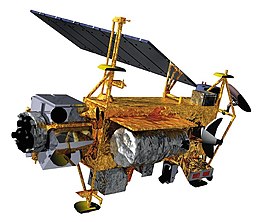
Back قمر صناعي لبحوث الغلاف الجوي العلوي Arabic Upper Atmosphere Research Satellite Czech Upper Atmosphere Research Satellite Danish Upper Atmosphere Research Satellite German Supratmosfera Esplorsatelito Esperanto Upper Atmosphere Research Satellite Spanish UARS Estonian Upper Atmosphere Research Satellite Basque UARS Finnish Upper Atmosphere Research Satellite French
 | |
| Mission type | Earth observation |
|---|---|
| Operator | NASA |
| COSPAR ID | 1991-063B |
| SATCAT no. | 21701 |
| Website | http://umpgal.gsfc.nasa.gov/ |
| Mission duration | 14 years, 3 months |
| Spacecraft properties | |
| Bus | MultiMission Modular Spacecraft |
| Manufacturer | Martin Marietta |
| Launch mass | 6,540 kilograms (14,420 lb) |
| Dry mass | 5,900 kilograms (13,000 lb) |
| Power | 1600.0 watts |
| Start of mission | |
| Launch date | 12 September 1991, 23:11:04 UTC |
| Rocket | Space Shuttle Discovery STS-48 |
| Launch site | Kennedy LC-39A |
| Contractor | NASA |
| End of mission | |
| Disposal | Decommissioned |
| Deactivated | 15 December 2005 |
| Decay date | 24 September 2011 |
| Orbital parameters | |
| Reference system | Geocentric |
| Regime | Low Earth |
| Semi-major axis | 6,953.0 kilometers (4,320.4 mi) |
| Eccentricity | 0.0003645 |
| Perigee altitude | 574.0 kilometers (356.7 mi) |
| Apogee altitude | 575.0 kilometers (357.3 mi) |
| Inclination | 56.97999954223633° |
| Period | 95.9 minutes |
| Epoch | 14 September 1991, 20:00:00 UTC[1] |
| Instruments | |
| CLAES ISAMS MLS HALOE HRDI WINDII SUSIM SOLSTICE PEM ACRIM II | |
The Upper Atmosphere Research Satellite (UARS) was a NASA-operated orbital observatory whose mission was to study the Earth's atmosphere, particularly the protective ozone layer. The 5,900-kilogram (13,000 lb) satellite was deployed from Space Shuttle Discovery during the STS-48 mission on 15 September 1991. It entered Earth orbit at an operational altitude of 600 kilometers (370 mi), with an orbital inclination of 57 degrees.
The original mission duration was to be only three years, but was extended several times. When the mission finally ended in June 2005 due to funding cuts, 14 years after the satellite's launch, six of its ten instruments were still operational.[2] A final orbit-lowering burn was performed in early December 2005 to prepare the satellite for deorbit. On 26 October 2010, the International Space Station performed a debris-avoidance maneuver in response to a conjunction with UARS.[3]
The decommissioned satellite re-entered Earth's atmosphere on 24 September 2011. Considerable media attention surrounded the event, largely due to NASA's predictions that substantial parts of the satellite might reach the ground, potentially endangering inhabited areas. However, the satellite ultimately impacted in a remote area of the Pacific Ocean.[4]
- ^ "NASA - NSSDCA - Spacecraft - Trajectory Details". nssdc.gsfc.nasa.gov. Retrieved May 1, 2018.
- ^ W. Henry Lambright, 2005. NASA and the Environment: The Case of Ozone Depletion, "The UARS controversy" p 43f.
- ^ Orbital Debris Quarterly News (PDF) (Report). Vol. 15. NASA Orbital Debris Program Office. July 2011. p. 2. Archived from the original (PDF) on October 20, 2011. Retrieved September 22, 2011.
- ^ "Final Update: NASA's UARS Re-enters Earth's Atmosphere". Retrieved September 27, 2011.
© MMXXIII Rich X Search. We shall prevail. All rights reserved. Rich X Search